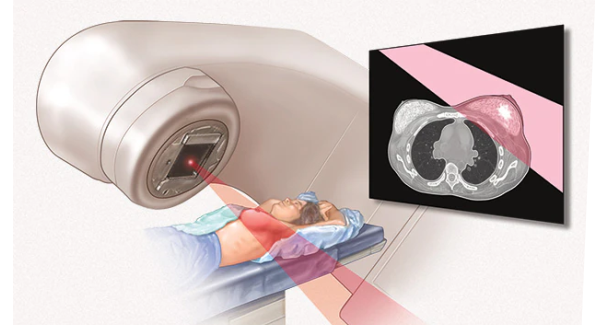Shining Light on Radiation Therapy: How it Works in Breast Cancer Care
Radiation therapy plays a crucial role in the treatment of breast cancer, offering targeted and effective therapy to destroy cancer cells while minimizing damage to healthy tissue. In this blog, we’ll shine a light on radiation therapy, exploring how it works, its benefits, and what to expect during treatment.
Understanding Radiation Therapy:
Radiation therapy, also known as radiotherapy, uses high-energy rays or particles to kill cancer cells or stop them from growing and dividing. It can be delivered externally using a machine called a linear accelerator (external beam radiation) or internally through radioactive implants (brachytherapy). Radiation therapy is often used after surgery (adjuvant therapy) to destroy any remaining cancer cells or before surgery (neoadjuvant therapy) to shrink tumors and make them easier to remove.
How Radiation Therapy Works:
During radiation therapy, high-energy radiation beams are precisely targeted at the tumor site or the area where the tumor was removed. These beams damage the DNA of cancer cells, preventing them from multiplying and spreading. Unlike chemotherapy, which affects the entire body, radiation therapy is localized to the treatment area, minimizing damage to surrounding healthy tissue.
Benefits of Radiation Therapy:
Radiation therapy offers several benefits in the treatment of breast cancer. It can reduce the risk of cancer recurrence after surgery, improve overall survival rates, and alleviate symptoms such as pain or discomfort. Radiation therapy is also a valuable option for patients who are not candidates for surgery or chemotherapy or who wish to preserve breast tissue (breast-conserving therapy).
What to Expect During Treatment:
Before starting radiation therapy, patients undergo a planning session called simulation, during which imaging scans are used to precisely map the treatment area. Treatment sessions are typically scheduled daily, Monday through Friday, for several weeks. Each session lasts only a few minutes, and the radiation is painless and non-invasive. Patients may experience mild fatigue or skin irritation during treatment, but these side effects are usually temporary and manageable.
Potential Side Effects:
While radiation therapy is generally well-tolerated, it can cause side effects such as skin irritation, fatigue, breast swelling, and changes in breast appearance or texture. These side effects typically resolve within a few weeks or months after treatment ends. Patients should follow their healthcare provider’s recommendations for skincare and symptom management to minimize discomfort and promote healing.
Radiation therapy is a vital component of breast cancer treatment, offering targeted therapy to destroy cancer cells and reduce the risk of recurrence. By understanding how radiation therapy works and what to expect during treatment, patients can feel more confident and empowered in their cancer journey. Remember, Pink Ribbon is here to provide guidance, resources, and emotional support every step of the way.







